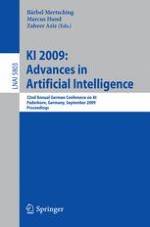The 32nd Annual German Conference on Arti?cial Intelligence, KI 2009 (KI being the German acronym for AI), was held at the University of Paderborn, Germany on September 15–18, 2009, continuing a series of successful events. Starting back in 1975 as a national meeting, the conference now gathers - searchers and developers from academic ?elds and industries worldwide to share their research results covering all aspects of arti?cial intelligence. This year we received submissions from 23 countries and 4 continents. Besides the inter- tional orientation, we made a major e?ort to include as many branches of AI as possible under the roof of the KI conference. A total of 21 area chairs represe- ing di?erent communities within the ?eld of AI selected further members of the program committee and helped the local organizers to acquire papers. The new approach appealed to the AI community: we had 126 submissions, which cons- tuted an increase of more than 50%, and which resulted in 14 parallel sessions on the following topics agents and intelligent virtual environments AI and engineering automated reasoning cognition evolutionary computation Robotics experience and knowledge management history and philosophical foundations knowledge representation and reasoning machine learning and mining natural language processing planning and scheduling spatial and temporal reasoning vision and perception o?ering cutting edge presentations and discussions with leading experts. Thirty-one percent of the contributions came from outside German-speaking countries.
